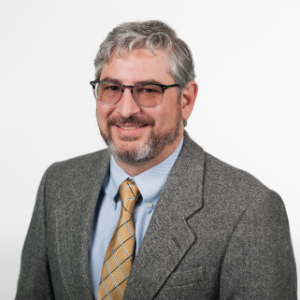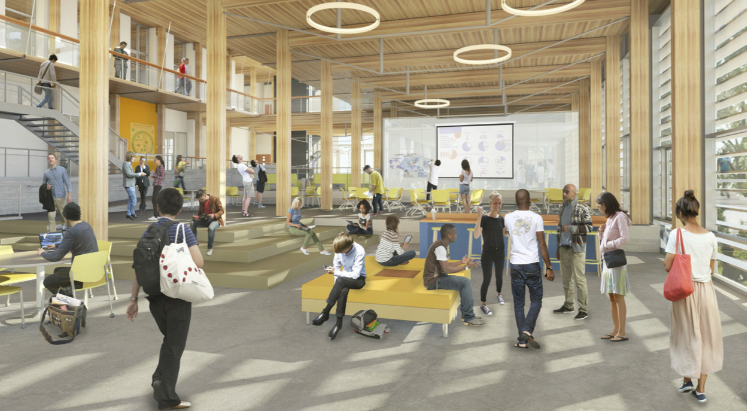Part 5 in our series on the Energy Petal in the Living Building at Georgia Tech. Read the previous article here.
The design team on the the Kendeda Building for Innovative Sustainable Design at Georgia Tech has a message for its buttoned-up campus: Relax.
As universities go, Georgia Tech can be a pretty formal place. It’s a culture befitting a nationally ranked engineering school — regularly swept through by venture capitalists, grant makers and corporate recruiters.
But “who says you need to go to work in a coat and tie?” asks Howard S. Wertheimer, institute architect for Georgia Tech. “We’ve got an opportunity to expand the comfort zone of our buildings.”
Many architects and engineers now admit that they’ve been designing overly conditioned indoor spaces for decades. Maybe, it’s taken a while to get all the complexities of indoor comfort just right. Maybe, it’s just the ecstasy one feels when escaping the sticky Georgia heat by walking into a cool building.
Make no mistake: Air conditioning transformed the South. Some historians contend it was as responsible as the Civil Rights Movement for the boom that swept across the region in the second half of the 20th century.
But a few things got lost along the way to progress. It wasn’t just that architects neglected porches, high ceilings, dogtrots and other passive features that had distinguished Southern architecture for generations. It also was that people began to occupy buildings in a way that separated them from the climate and natural landscape around them. That artificial approach hasn’t always made everyone more comfortable: Some people love the cold blast that greets them on a summer day as they enter a commercial building; others respond to it with an arctic shiver.
Researchers, modelers and mechanical engineers have strived for years to overcome the fact that comfort is subjective. Nobody knows better than one’s self whether it’s too hot, too cold, or just right.
But professionals have long tried to boil the challenge of thermal comfort into objective criteria. Design standards developed by ASHRAE and other organizations have established acceptable ranges for temperature and humidity. A building is doing well, they surmise, if 80 percent of its occupants are comfortable at any particular moment.
ASHRAE breaks down thermal comfort into six factors:
- Air temperature: The “dry bulb” temperature that can be measured by a thermometer
- Radiant temperature: A weighted average of surface temperatures in the room
- Relative humidity: The percentage of water vapor in the air around the occupant
- Air velocity: The rate of air movement in the room
- Metabolic rate: Energy generated by the occupant (based on the person’s level of exertion)
- Clothing: Insulation the occupant is wearing
Those six categories clarify an important point: Conventional heat and cooling systems don’t take advantage all the tools that are available. At most, forced-air systems — and even more advanced HVAC setups, like those planned for the Kendeda Building — are designed to employ the first three of the six factors.
In the Kendeda Building, for example, radiant floors address both air and radiant temperatures. A tight building envelope will prevent moist, untreated outside air from coming into the building, and a dedicated outside air system (DOAS) will reduce much of the humidity as it’s being pulled into the building.
But what about the other factors?
“One of the things that excites me most about this project is that we’re taking on at least five of them,” says Alissa Kingsley, a Lord Aeck Sargent architect on the design team.

The most obvious of those frequently neglected strategies is air velocity. Moving air inside a building makes you feel cool in the same way that wind blowing through your air cools you while you’re riding in a comfortable. There’s nothing new to the idea. Before air conditioning came along, fans were the main mechanical tool people used to cool people in a hot building.
Fans — at least the way they’re being employed in the Kendeda Building — actually do little to reduce a building’s indoor temperature. But they do make us feel cooler by whisking away the body heat around us. By focusing on how people feel rather than on lowering an entire building’s temperature, fans can make improving comfort less costly — in terms of both energy and money.
The Kendeda Building will rely on fans in a big way. On warm days, large fans on the ceiling of the building’s atrium will generate air velocity at the rate of up to 150 feet per minute. In classrooms and work spaces, fans will have a slightly lower maximum velocity, mainly to avoid such practical problems as paper blowing off desks.
The fans are expected to reduce the amount of energy the building expends on lowering temperatures and humidity because they’ll allow building operators to set a slightly higher combination of temperature and humidity in exchange for more air movement, says Marc Brune, lead engineer on the design team and an associate principal at PAE Engineers in Portland, Oregon.
Of course, theory can differ from practice.
“All things being equal, people will feel comfortable with a higher temperature if there’s a fan moving air in the room,” says Georgia Tech’s Greg Spiro. “But you also can push too far. The worst thing for this building would be if people were uncomfortable and didn’t want to go there.”
Spiro is paid to be skeptical. A senior mechanical engineer in the Georgia Tech Facilities Management office, he scrutinizes HVAC plans proposed by construction contractors on campus. “We are doing so many things differently in [the Kendeda Building],” he says. “It’s really exciting. But it also worries me sometimes.”

Spiro wanted to see for himself how students would respond to conditions that differed from those they’re used to in other campus buildings. He was particularly concerned about a proposed relative humidity “set point” of 60 percent. (The set point is an operating condition that the climate system is designed to meet.) And he wanted to make sure that members of the project team saw the response alongside him. So, with permission from the professor in charge, Spiro commandeered a campus lab that’s usually used to test whether sports drinks cool off athletes. Then, he performed an informal experiment.
The baseline condition outside the test chamber was the “GT standard” for a conditioned space: 73 degrees Fahrenheit and 50 percent relative humidity. In the chamber itself, “we added very basic box-type fans, and we used the different speed controls.”
The conditions tested were: 78 degrees, 55 percent humidity and a wind velocity of 100 feet per minute, 80/60/100 and 80/60/150. The results? “All over the map,” Spiro says, but he adds: “The general feeling was that a relatively humidity above 50 percent” caused occupants to feel uncomfortable.
Brune, the mechanical engineer at PAE in Portland, couldn’t make it to the experiment. Still, he had a different perspective.
“Let’s put it this way,” Brune said. “There was creative tension between the design team and the owner’s team with regard to comfort, and I think what it highlighted is an area where our profession really needs more research, because from my point of view we could really push it farther.”
He points out that Spiro was unable to replicate the impact that radiant floors will have on occupants. A cooled concrete floor below a person’s feet will make that person feel cooler regardless of the air temperature.
Nonetheless, the project team agreed to lower the humidity set point to 50 percent. That lower humidity target didn’t require PAE to make any physical changes to the mechanical system. But it did increase the building’s projected energy demand. And because all the building’s energy must be generated by its solar panels, that means more money will have to be spent on the building’s rooftop array.
For now, at least, the cooling set point in classrooms, study areas, offices and other programmable spaces will be 78 degrees and 50 percent humidity with 100 feet per minute of air velocity. A higher air velocity in the atrium, 150 fpm, will allow for a temperature as high as 80 degrees. Brune had proposed the same temperature and air velocity levels, except with up to 60 percent humidity.
“We’re building a little more cushion into the design of the building than hopefully they’ll need at the end,” Brune says. “I hope that once we’re actually running that building and we have slab in there and air movement, people will feel comfortable, and they’ll be able to run it at a different level.”
Spiro notes that those cooling temperatures remain considerably higher than normal. But members of the design team are confident that occupants will be very comfortable. They note that ASHRAE 55, the professional standard for thermal comfort, allows temperatures and humidity within that range, and it’s based on studies showing that 80 percent of occupants are comfortable within those ranges.
“You’re never going to make everybody happy,” says Lord Aeck Sargent’s Kingsley. “Some people just are going to like it colder, and some are going to like hotter. Some people may just be sitting in front of a computer, and others are going to generate a lot of heat because they have to do something more active inside the building. But I’m feeling really good about where we are.”


